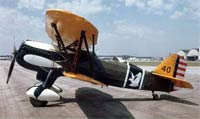
Curtiss P-6E
Snow Owl Extreme
If we were to have a show of hands to pick the most beautiful American pre-war biplane fighter, once someone nominated the Curtiss P-6E, the voting would be over. When it comes to sheer physical attraction, the P-6E blows all other American production biplane fighters into the weeds. Nothing else comes close.
For a decade beginning in the mid-1920’s Curtiss produced a wide ranging series of biplane fighters all of them using the original formula of the P-1 Hawk in which a tube fuselage structure was married to a pair of highly tapered wings, which became a Hawk signature. Along the way, the fuselages of the various fighters continued to evolve and mutate, slowly working their way up to the epitome represented by the 1931 P-6E.
One has only to sit back and study the P-6E to see where Curtiss’s involvement in racing during the 1920’s resulted in experience that was applied directly to the P-6E: every effort was made to let it slide through the air as cleanly as possible, which, for a biplane, isn’t easy. The 700 hp 12-cylinder Curtiss Conqueror engine was cloaked in a hand-hammered aluminum cowling that is nothing if not sensual. The “V” type shock-cord landing gear of the earlier Hawks gave way to a single-strut landing gear that even 70 years later, drove replicators nuts trying to duplicate: it was a long, hollow tapered tube with the wheels on one end and shock units on the other. Even with today’s computer controlled machining capabilities, it wasn’t an easy thing to duplicate.
The wheel pants, which were hammered out of aluminum sheet, were works of art unto themselves. However, before the airplane was officially retired in 1937, many P-6E’s had been equipped with modified pants that exposed the wheel in side view. This made servicing easier and eliminated clogging the wheel pants with mud that resulted in rather abrupt, usually damaging, landings, when the wheels wouldn’t turn on touchdown. In truth, the service history of the bird wasn’t good: of the original 46 procured by the Air Corp, 27 were written off in accidents.
The Conqueror engine and its Curtiss predecessors were, at the time, pure state of the art. A V-12, it relied heavily on magnesium for light weight, one of many reasons few have survived to modern times in runnable condition: magnesium loves to corrode and turns to powder with age. In the P-6E, the Conqueror turned a three-blade, ground-adjustable propeller, meaning the blade angles could be manually adjusted to get maximum performance for the temperature and altitude in which the airplane was operating. They could also be set to maximize climb over speed or vice versa.
Alas, beauty doesn’t guarantee an airplane’s long-term survival and only one original P-6E is known to exist. It is displayed at the Air Force museum in Dayton, Ohio and is resplendent in the famous snow owl paint job of the 17th Pursuit Squadron, 1st Pursuit Group that was based at Selfridge Field in the early 1930’s. The EAA museum in Oshkosh, Wisconsin, however, displays an exact, flying replica (it hasn’t flown due to engine problems) that was painstakingly built over a 20-year period.
Want another Peanut Pirep? Return to PEANUT.